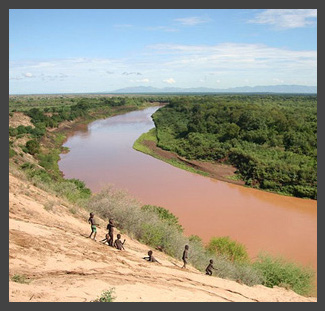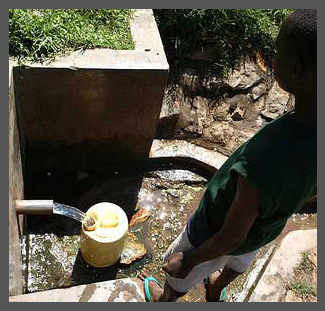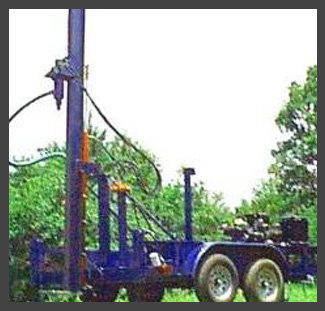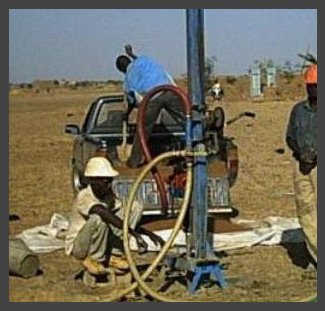Difference between revisions of "獲取地下水"
From Akvopedia
(Created page with "ㄇ") |
|||
| Line 1: | Line 1: | ||
| − | + | {{Language-box|english_link=Groundwater access |french_link=L'accès aux eaux souterraines |spanish_link=Coming soon|hindi_link=Coming soon|malayalam_link=Coming soon|tamil_link=Coming soon | korean_link=Coming soon | chinese_link=Coming soon | indonesian_link=Coming soon | japanese_link= Coming soon}} | |
| + | 雨水如能順利入滲,最終即成為地下水。收集地下水是件有利的做法,因其不論雨季隨時可得、普遍來說有著高貯水容量及優良水質、對於年際氣候的適應力高、以及與替代來源相較之下擁有較低成本。 | ||
| + | |||
| + | 然而,影響地下水位的高度有許多因素:地表面下的土壤及岩石型態、鄰近的蓄水池或河流,及鄰近居民抽水的頻率或總抽取水量。再者,地下水的品質也需納入考量-是否太鹹或太靠近附近的農業逕流或污水區。入滲及抽水地點須設置於水最不會被污染源影響的地方。 | ||
| + | |||
| + | '''氣候變化因素'''<br> | ||
| + | 氣候變化會影響全球降雨量及動態溫度,因而會影響地方社區對於水的供給及需求。普遍認為提升在地面上以及地面下的儲水量是應對水文衝擊(如洪水及乾旱)的策略。 | ||
| + | |||
| + | |||
| + | <div style=" background-color: #efefef; text-align: center; -moz-border-radius: 2px; -webkit-border-radius: 2px; border: 5px solid #dedede; padding: 5px;" > | ||
| + | {|cellpadding="3" cellspacing="0" width="100%" | ||
| + | |- | ||
| + | |colspan="5" style="background-color:#efefef;"| | ||
| + | |- | ||
| + | |style="background:#efefef;"|[[Image:riverbed infiltration galleries small.jpg|center|100px|link=Riverbed infiltration galleries]] | ||
| + | |style="background:#efefef;"|[[Image:SpringwaterCollecting small.jpg|center|100px|link=Springwater collection]] | ||
| + | |style="background:#efefef;"|[[Image:Subsurface harvesting systems small.jpg|center|100px|link=Subsurface harvesting systems]] | ||
| + | |style="background:#efefef;"|[[Image:Small rotary machines small.jpg|center|100px|link=Small rotary machines]] | ||
| + | |style="background:#efefef;"|[[Image:Jetting - Engine powered rotary jetting small.jpg|center|100px|link=Jetting - Engine powered rotary jetting]] | ||
| + | |- | ||
| + | |style="background:#efefef;"|<div class="center" style="width:auto; margin-left:auto; margin-right:auto;">[[Riverbed infiltration galleries|Riverbed <br> infiltration galleries]]</div> | ||
| + | |style="background:#efefef;"|<div class="center" style="width:auto; margin-left:auto; margin-right:auto;">[[Springwater collection|Springwater <br>collection]]</div> | ||
| + | |style="background:#efefef;"|<div class="center" style="width:auto; margin-left:auto; margin-right:auto;">[[Subsurface harvesting systems|Subsurface <br>harvesting systems]]</div> | ||
| + | |style="background:#efefef;"|<div class="center" style="width:auto; margin-left:auto; margin-right:auto;">[[Small rotary machines|Small rotary<br> machines]]</div> | ||
| + | |style="background:#efefef;"|<div class="center" style="width:auto; margin-left:auto; margin-right:auto;">[[Jetting - Engine powered rotary jetting|Jetting - Engine <br>powered rotary jetting]]</div> | ||
| + | |- | ||
| + | |colspan="5" style="background-color:#efefef;"| | ||
| + | |} | ||
| + | </div> | ||
| + | |||
| + | <br> | ||
| + | ===Field experiences=== | ||
| + | <br> | ||
| + | {|style="border: 2px solid #e0e0e0; width: 20%; text-align: justify; background-color: #e9f5fd;" cellpadding="2" | ||
| + | <!--rsr logo here--> | ||
| + | |- style="vertical-align: top" | ||
| + | |[[Image:akvorsr logo_lite.png|center|60px|link=http://akvo.org/products/rsr/]] | ||
| + | <!--project blocks here--> | ||
| + | |- style="vertical-align: bottom" | ||
| + | |[[Image:project 473.jpg |thumb|center|140px|<font size="2"><center>[http://rsr.akvo.org/project/473/ RSR Project 473]<br>Project Water4Tomorrow</center></font>|link=http://rsr.akvo.org/project/473/ ]] | ||
| + | |} | ||
| + | |||
| + | <br> | ||
| + | |||
| + | ===Groundwater links=== | ||
| + | * [[Sustainable Sanitation & Groundwater Protection]] | ||
| + | * [http://www.indiawaterportal.org/articles/key-successfully-managing-groundwater-india The key to successfully managing groundwater in India] | ||
| + | * [http://www.nwp.nl/_docs/Smart-solutions-3R.spread.pdf 3R Smart Solutions] | ||
| + | * <font size="3">[http://www.bgs.ac.uk/africagroundwateratlas/index.cfm Africa Groundwater Literature Archive]</font>: The Archive is a searchable database of published and unpublished groundwater literature about Africa, including reports, journal articles, conference papers and maps. Many of these documents are freely available to download; for others, a link is provided to the online abstract, or a full bibliographic reference is given where the document is not known to be available online. | ||
| + | * VIDEO: [http://www.thewaterchannel.tv/en/videos/categories/displayresults/0?pattern=manual%20drilling&rpp=10&sort=0&ep=&ex= Lots of manual drilling videos]. Produced by UNICEF. | ||
| + | * Arjen van der Wal, [http://www.unicef.org/wash/files/04.pdf UNDERSTANDING GROUNDWATER & WELLS In Manual Drilling: INSTRUCTION HANDBOOK for manual drilling teams on hydro-geology for well drilling, well installation and well development]. Practica Foundation. June 2010 (2nd Edition). French version: [http://www.practica.org/wp-content/uploads/services/publications/drilling%20manuals/FR/Understanding%20Groundwater%20%26%20Wells%20PRACTICA%20FR%20June%202010.pdf CONNAISSANCES DES METHODES DE CAPTAGE DES EAUX SOUTERRAINES: appliquées aux forages manuels]. | ||
| + | * [http://www.bgs.ac.uk/research/groundwater/international/africangroundwater/home.html Groundwater resilience to climate change in Africa.] Keyworth, Nottingham. British Geological Survey 2011. | ||
| + | * [http://www.un-igrac.org/dynamics/modules/SFIL0100/view.php?fil_Id=135 Global Overview of Saline Groundwater Occurrence and Genesis.] IGRAC, 2009. | ||
| + | * [http://www.iaea.org/technicalcooperation/documents/Brochures/sust-groundwater.pdf Sustainable Development of Groundwater Resources in Southern and Eastern Africa.] International Atomic Energy Agency. | ||
| + | * [http://www.rural-water-supply.net/en/resources/details/187 Siting of Drilled Water Wells - A Guide for Project Managers] RWSN Field Note 2010-5 (Cost Effective Boreholes Series). Carter, R., Chilton, J., Danert, K. et al. RWSN. St Gallen, Switzerland 2010. | ||
| + | |||
| + | <br> | ||
| + | |||
| + | ===Acknowledgements=== | ||
| + | * [https://ccafs.cgiar.org/publications/management-groundwater-africa-including-transboundary-aquifers-implications-food#.ViVlZxCrTyI Management of Ground Water in Africa Including Transboundary Aquifers: Implications for Food Security, Livelihood and Climate Change Adaptation.] United Nations Economic Commission for Africa, African Climate Policy Centre, 2011. | ||
Revision as of 05:18, 20 October 2015
| |
|
|
|
|
|
|
|
|
雨水如能順利入滲,最終即成為地下水。收集地下水是件有利的做法,因其不論雨季隨時可得、普遍來說有著高貯水容量及優良水質、對於年際氣候的適應力高、以及與替代來源相較之下擁有較低成本。
然而,影響地下水位的高度有許多因素:地表面下的土壤及岩石型態、鄰近的蓄水池或河流,及鄰近居民抽水的頻率或總抽取水量。再者,地下水的品質也需納入考量-是否太鹹或太靠近附近的農業逕流或污水區。入滲及抽水地點須設置於水最不會被污染源影響的地方。
氣候變化因素
氣候變化會影響全球降雨量及動態溫度,因而會影響地方社區對於水的供給及需求。普遍認為提升在地面上以及地面下的儲水量是應對水文衝擊(如洪水及乾旱)的策略。
Field experiences
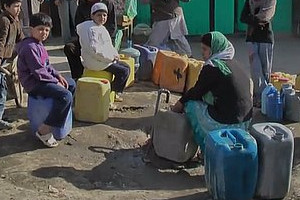 Project Water4Tomorrow |
Groundwater links
- Sustainable Sanitation & Groundwater Protection
- The key to successfully managing groundwater in India
- 3R Smart Solutions
- Africa Groundwater Literature Archive: The Archive is a searchable database of published and unpublished groundwater literature about Africa, including reports, journal articles, conference papers and maps. Many of these documents are freely available to download; for others, a link is provided to the online abstract, or a full bibliographic reference is given where the document is not known to be available online.
- VIDEO: Lots of manual drilling videos. Produced by UNICEF.
- Arjen van der Wal, UNDERSTANDING GROUNDWATER & WELLS In Manual Drilling: INSTRUCTION HANDBOOK for manual drilling teams on hydro-geology for well drilling, well installation and well development. Practica Foundation. June 2010 (2nd Edition). French version: CONNAISSANCES DES METHODES DE CAPTAGE DES EAUX SOUTERRAINES: appliquées aux forages manuels.
- Groundwater resilience to climate change in Africa. Keyworth, Nottingham. British Geological Survey 2011.
- Global Overview of Saline Groundwater Occurrence and Genesis. IGRAC, 2009.
- Sustainable Development of Groundwater Resources in Southern and Eastern Africa. International Atomic Energy Agency.
- Siting of Drilled Water Wells - A Guide for Project Managers RWSN Field Note 2010-5 (Cost Effective Boreholes Series). Carter, R., Chilton, J., Danert, K. et al. RWSN. St Gallen, Switzerland 2010.
Acknowledgements
- Management of Ground Water in Africa Including Transboundary Aquifers: Implications for Food Security, Livelihood and Climate Change Adaptation. United Nations Economic Commission for Africa, African Climate Policy Centre, 2011.
